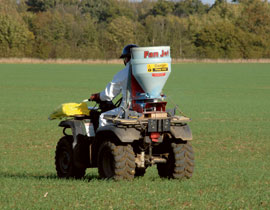Water companies issue metaldehyde warning

Tighter restrictions may be necessary if voluntary measures fail to reduce residues from metaldehyde slug pellets in watercourses, water companies have warned.
It follows confirmation that metaldehyde levels 40 times higher than EU drinking water standards have been found in rivers and watercourses this autumn.
Water UK, the body which represents water companies, has issued a briefing paper on the problem of metaldehyde in drinking water sources.
There were two options if voluntary measures by farmers failed to generate sustainable reductions in metaldehyde levels in drinking water sources, it suggested.
“It may be necessary for the introduction of tighter environmental restrictions or for water companies to invest in the development of advanced treatment solutions to protect essential water supplies.”
Measurements of the chemical used in slug pellets have been detected at more than 4ppb in some watercourses – 40 times higher than the 0.1ppb EU standard for drinking water.
Current drinking water treatment methods designed to remove a range of pesticides were not effective at reducing metaldehyde levels, said Water UK.
Although there was no health risk from the metaldehyde levels being detected in water supplies, EU legislation said pesticides should not be present in drinking water.
The most sustainable solution was to control the pesticide at source to prevent metaldehyde getting into watercourses and rivers in the first place, said Water UK.
This was best achieved by changing the way metaldehyde was used.
Until this year, there had been a demonstrable downward trend in the number of occasions metaldehyde had been detected in raw and treated water.
But a wet, mild summer and autumn in 2012 had seen a significant increase in slug activity to levels which challenge crop yields.
“The result has been an increase in concentrations of metaldehyde in rivers, reservoirs and canals across large parts of England,” said Water UK.
Some catchments had recorded the highest metaldehyde concentrations since intensive monitoring began, it added.
Given that climatic variation was likely to become more extreme, the water industry needed to be certain that any measures taken to protect drinking water sources were robust.
“The measures taken to date have shown benefits but may be stretched in certain conditions to meet the drinking water standard,” said Water UK.
“There needs to be a multiple barrier approach to dealing with challenges such as metaldehyde.”
In the first instance, the water industry remained committed to working with farmers to ensure that metaldehyde did not find its way into rivers and reservoirs.
It also fully supported the voluntary measures and catchment management approaches undertaken by the Metaldehyde Stewardship Group.
The group’s Get Pelletwise campaign urges farmers to adhere to best practice guidelines on metaldehyde to help achieve compliance with drinking water standards.
Read about growers’ concerns over metaldehyde levels
More information about Get Pelletwise

